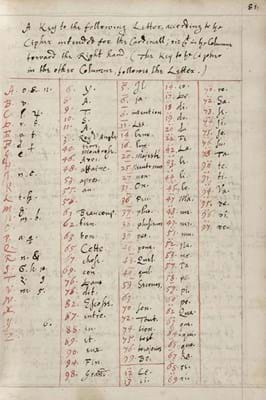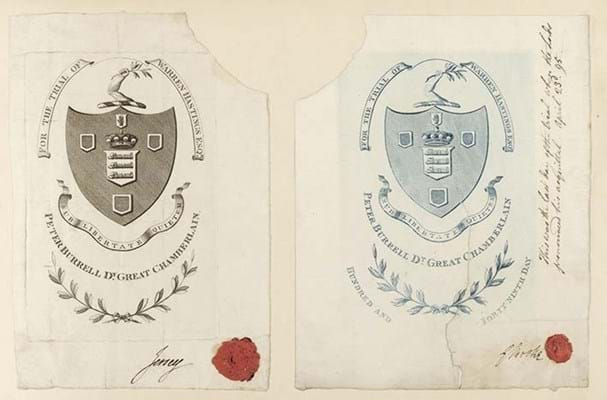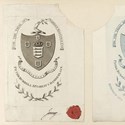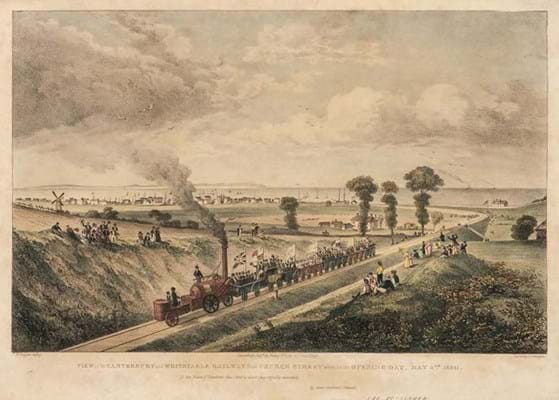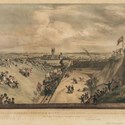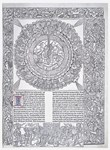Though not the most visually appealing of lots in a Gloucestershire sale, the leaf shown above comes from a “highly important document in the history of cryptography”.
Dating from 1653, it is part of an unpublished manuscript by a leading mathematician of the age, John Wallis, and relates to his pioneering contribution to the science of code breaking. On October 7 this ‘Collection of Letters and Papers, intercepted in Ciphers, during the late warres in England…’ was sold by Dominic Winter (20% buyer’s premium) for £29,000.
A clergyman’s son who claimed to be self-taught in mathematics, Wallis was appointed Savilian Professor of Geometry at Oxford in 1649.
A founding member of the Royal Society, works such as Arithmetica infinitorum (1655), Mechanica (1670- 71) and A Treatise of Algebra (1685) established his reputation as the most important English mathematician before Newton – on whom that first named work was a major influence, said the cataloguer.
Wallis’ cryptographic feats, however, provoked both hostility and admiration in contemporaries. Thomas Hobbes was appalled at his revelations concerning royalist communications but Leibniz repeatedly tried to persuade Wallis to reveal his methods to a wider audience.
In this manuscript 53 coded letters exchanged by royalists between 1640-58 are accompanied by the deciphered text and a detailed key, but four others are left unsolved as exercises for would-be cryptographers.
The saleroom noted that Wallis’ cryptographic achievements are an aspect of his career entirely ignored by a recent biographer, who remarks that “…although Wallis’s deciphering activity would be a fascinating story, in the interests of space, it has been left out of this book”.
Calling ET
A 1698, first English edition of Christian Huygens’ The Celestial Words Discover’d…, an early inquiry into the possibilities of extra-terrestrial life, realised £3400.
Sold at £22,000 was a copy in a rebacked period binding of the first English edition of Newton’s Mathematical Principles…, a two-volume translation by Andrew Motte issued in 1729 – some 42 years after the original Latin appearance of this celebrated work as Principia Mathematica….
Barely a week later, on October 13, Hansons (25% buyer’s premium) sold a copy at £24,000, while on October 27 Swann Galleries (25/20/12%) took $38,000, (£29,230) for a copy in a modern, but period-style binding
Halley to Franklin via Simson
Back with Dominic Winter now, where £11,500 secured an association copy in contemporary calf of an edition of Sphaericorum…, a classical text by Menelaus of Alexandria that was edited by Edmond Halley but only printed some years after his death, in 1758.
It was given to Benjamin Franklin by the Scottish mathematician Robert Simson when they met during a six-week tour of Scotland that Franklin made during his 1757-62 residence in Britain.
Granted a doctorate by the University of St Andrews and the freedom of Edinburgh, Franklin met David Hume, Adam Smith and other major figures at the time and later referred to the tour as “six weeks of the greatest happiness I have known”.
Sold at £12,200 was an 1820-21 manuscript journal of a ‘Voyage to Hudson’s Bay and the Red River Settlement’. Running in diary form to some 8000 words over 23pp, it documents the experiences of the first year that its author, John West – who later published a more substantial Journal of his years in Canada – spent as a missionary in the Manitoba region of Canada.
The miniscule nature of a manuscript of 1823-24 by William Ellis called ‘Polynesian Researches’ that made £7200 makes it a challenging read. In a tiny hand he squeezes up to 5000 words on each of the many quarto pages of what may have been groundwork for the three volume work of the same name that he published in 1829-31.
Sold at £3000 were four from a set of six coloured prints dating from the first few years of the 19th century and presenting bird’s-eye views of the London docks by William Daniell. They were among a first selection of 100 lots from a print collection assembled by structural engineer David Smith that focuses on topographical views and panoramas, railways and steamships, bridges, ports, etc.
Bid to £800 was a pair of coloured litho prints of 1830 celebrating the opening of one of the world’s first public passenger steam railway services. A single track line between Canterbury and the seaside town and fishing port of Whitstable, it was constructed by the engineering firm of Locke & Dixon under the direction of George and Robert Stephenson.
The latter attended the line’s grand opening in May 1830 and wrote at the time “…it went off remarkably well without a single mishap”. Only a few months later, however, the Liverpool MP William Huskisson was famously killed in an accident involving Stephenson’s Rocket at the opening of the Liverpool and Manchester Railway.


